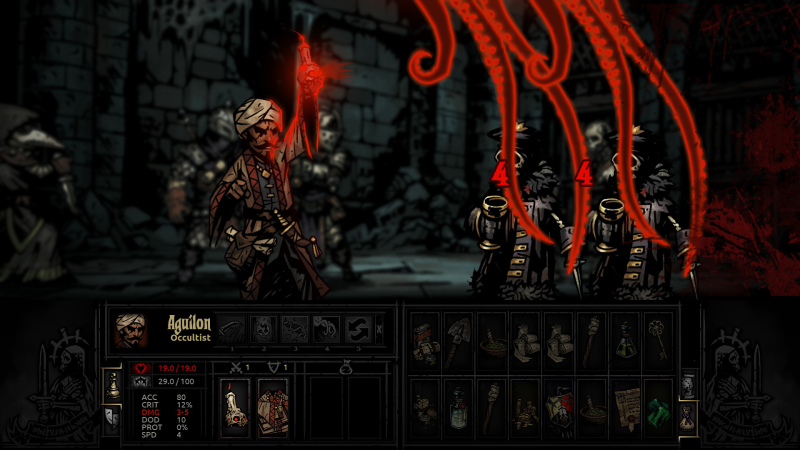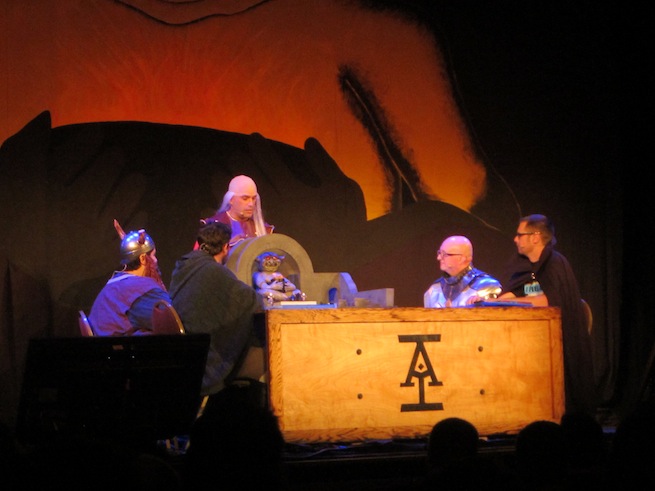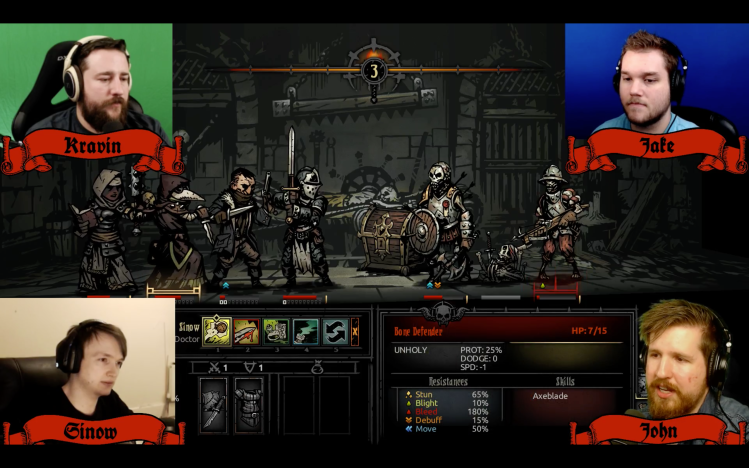Why face the sanity-breaking horrors of Darkest Dungeon alone when you could use the buddy system? For over a month now, livestreamer and YouTube creator John Wolfe has been playing the role-playing game Darkest Dungeon with three other friends, effectively turning a single-player game into a multiplayer co-op. He runs it like a campaign of Dungeons & Dragons, which led to the stream’s name: “Darkest Dungeons & Dragons.”
Red Hook Studios’s Darkest Dungeon is a roguelike with grimdark flair. It raised nearly $315,000 on Kickstarter in 2014, and it left early access last year. It’s now on PC, PS4, and Vita. Normally, one player selects four characters to explore dungeons, slay eldritch horrors, and collect treasure. Each character has a sanity meter, which dips when characters take damage or the darkness deepens, or simply as the stress of adventuring mounts in the depths of what sometimes looks like Cthulhu’s lair.
“My friend, SinowBeats and I, were talking about Darkest Dungeon one day, and at one point we talked about how it would be cool to stream it together,” said Wolfe in an email to GamesBeat. “At first, we were thinking about possibly one person playing the game as a backdrop for a podcast, but then I brought up the idea of getting four of us together to each take ‘responsibility’ for one of the four characters in our party.”
Wolfe had played turn-based RPGs as couch co-op before, passing the controller back and forth with a friend while they each took control of different characters. He says that these experiences became repetitive, but both he and his friend noticed that they’d developed a connection with their own characters.
“We played through Gears of War, Left 4 Dead, Resident Evil 5, Dungeon Defenders, and plenty more,” said Wolfe. “We got to the point where we ran out of games to play co-op, so we decided to play some turn-based RPGs but pass the controller to each other after taking one character’s turn. It was especially fun to do with Legend of Dragoon — I would play as Dart, the main character, and [my friend] would play as Lavitz (or Albert).”
It might be fun to play a single-player game this way, but it seems it’s also fun for folks to watch. Wolfe has streamed Darkest Dungeons & Dragons seven times so far on Wednesdays from 5 p.m. to 8 p.m. Pacific., and each session draws an average of 200-300 concurrent viewers each evening. It gets a higher viewership than his other streams — like when he plays the roguelike action platformer Dead Cells — and he also notices people showing up who are outside of his normal audience.
“I do notice different crowds showing up — possibly from scrolling through Darkest Dungeon streamers and doing a double take when they see the word ‘co-op,'” said Wolfe. “The tone for the stream is quite different from a solo DD stream, as well — while someone who’s streaming the game solo might be concentrating on playing the game well and preventing their characters from dying, since there are four of us we spend most of our time joking around and ribbing each other. We still take the game seriously when we have to, but ‘fun’ is the priority.”
Wolfe says that viewership for his streams and videos vary depending on what he’s playing. Primarily known for playing horror games, he’s also streamed games like Mirror’s Edge and the popular massively multiplayer shooter PlayerUnknown’s Battlegrounds.
“The success of your gaming video content, whether it’s on YouTube or Twitch, is dependent on being in the right place at the right time with the right game,” said Wolfe.

Above: The Occultist using Abyssal Artillery, which attacks the enemy in the last two positions.
How it works
Wolfe is at the helm of the multiplayer stream, running Darkest Dungeon on his computer and clicking the mouse to execute attacks. However, the four players divvy up the party, each claiming a character and naming it after themselves. During the turn-based combat, they tell Wolfe what move they want their character to make.
“We not only decide our characters’ moves, but we decide how to navigate the dungeon as a party — whether to spend or save supplies, when to retreat, how to manage inventory, things like that,” said Wolfe.
When the streams began, Wolfe and one other player had played Darkest Dungeon before. The other two players came in with only a cursory knowledge of the game. Hijinks emerged from the four of them traipsing through the perilous gloom, discovering different traps, and triggering horrifying events — like when the group voted against the wisdom of one of the more experienced players to offer a torch to a shrine. That move summoned an eldritch monstrosity that was way too powerful for a couple of level 1 adventurers to deal with.
Though there might be an occasional scramble for survival, Wolfe and the other players cooperate on most things. They vote on what items to keep — for instance, choosing to prioritize heirlooms that can help them upgrade buildings back in town — and they decide when to rest and heal during longer quests. They take turns on who plays the vestal, which is a character class that’s often the designated healer, and decide democratically who will act as the tank in front.
Co-op play for Darkest Dungeon makes sense. It’s a game that emphasizes teamwork, especially since one character’s stress can affect other party members. Cofounder Tyler Sigman says it’s something that Red Hook has considered adding before, and some fans have even asked for it.
“I didn’t personally know anyone was doing co-op but the thought of that has crossed our minds a bunch. Sometimes people say ‘Make it multiplayer!’ and they specifically mean co-op,” said Sigman in an email. He added, “I’ve been waiting for a ‘Twitch Plays DD’ and think it would be neat.”
Sigman says their team watches a lot of Darkest Dungeon streams on Twitch, and notes that they’ve generally had a lot of success on the platform. He says that because the combat is turn-based, it enables the streamers to engage viewers and react to what’s happening in the game.
“Also, the attachment to the heroes and the ability to name them after [subscribers] or friends creates social investment,” said Sigman. “The permadeath also helps make it interesting as a spectator, because it heightens tension and makes the audience feel that they are watching something that matters.”
Anyone who’s watched a live D&D game, be it Acquisitions Inc. or HarmonQuest, knows that the interplay between the players is half the fun. Darkest Dungeon & Dragons certainly has that, but it’s missing one key component of a D&D session — the Dungeon Master (DM).
The DM is an integral part of D&D, creating the world and driving the story forward. Mike Mearls, senior manager of the D&D design and development team at Wizards of the Coast, calls the DM “one of the big innovations of tabletop roleplay.”
“D&D is at its best when both the players and Dungeon Master create unexpected events during a game,” said Mearls in an email. “If you play by a script or closely follow the adventure or the rules, the game can grow stale.”
In the case of Wolfe’s stream, the game itself sort of acts like a DM, dictating the scenario and “rolling” for the players and enemies using a random number generator. It’s not a perfect analog, but commentary from all four players can also add an additional layer of storytelling — such as when they react to the different “quirks” that are adding to their characters.
When you recruit characters in Darkest Dungeon, they come with a set of negative and positive traits. Going through a harrowing dungeon can also add quirks, such as a sudden bout of “fear of mankind” or “Satanophobia.” The players sometimes role-play these sudden developments in their characters. This definitely takes a cue from around the D&D table, where sometimes players agree to avoid acting or talking out of character.
Mearls says that he thinks it’s fantastic when people apply ideas and principles from D&D to other games.
“We think of D&D as a training ground for game designers, storytellers, and other creators,” said Mearls. “One of the core principles of the D&D creative team is that we’re here to help shepherd tomorrow’s creators. When we see the game influencing people and helping them discover their creative voice, we know we’re living up to that vision.”

Above: A game of Dungeons & Dragons with Acquisitions Incorporated at PAX Prime 2012.
Getting creative
Erin “Aureylian” Wayne has been producing video for nearly six years, both on YouTube and via livestreams, and she’s on the board of directors of the Internet Creators Guild trade association. She’s mainly a streamer on Twitch, and she’s also the platform’s lead community manager. She says that coming up with a different take on a game, like Darkest Dungeon & Dragons, isn’t just for the benefit of the viewers.
“But aside from that, there’s also this point where, if you’re a creator, and you’ve played the same game for thousands of hours, how do you not get burnt out?” said Wayne in a phone call. “Coming up with new and creative and innovative ideas to keep doing the same content, but in a completely different way, prevents you from getting that burnout, especially when that’s what your audience knows and expects and wants.”
Content creators online are under a lot of pressure to constantly upload videos. Wolfe says that a lot of channels take the tack of uploading a lot of videos at a steady drumbeat, measuring their output by numbers.
“A lot of content creators on Twitch and YouTube that make gaming content have a very gaming-centric perspective on value. They measure things in hours,” said Wolfe. “When a new game comes out, the first thing you see about it is how many ‘hours’ it is. Oh, that game’s $60, but the campaign’s only four hours. Or, that game’s $20, but I’ve logged 200 hours in it.”
Wolfe says that it’s a legitimate strategy, but he would rather post and stream less frequently if he feels that the quality is higher. By posting at a slower rate, he’s also guarding against burnout, which can happen during longer streams that can last over five hours.
Gaming-related videos could generate $4.6 billion this year alone, research firm SuperData predicts, yet video creators are struggling to stay afloat and not just because of burnout. What’s been dubbed the YouTube Adpocalypse has slashed revenue for everyone on that platform for the past few months.
Essentially, companies can now select what kind of content they want their ads associated with. As a side effect, YouTube’s algorithm now seems to be demonetizing videos at a much higher rate than before. Many are supplementing their YouTube channels with Patreon, a subscription platform, and Twitch.
Demonetization aside, Wolfe says that the sheer number of videos on platforms like YouTube and Twitch will also force content creators to rely on other strategies and to get more creative in the future. He predicts that there will be more out-of-the-box thinking when it comes to video ideas, and it might not be enough just to post a play-through of something.
“As the market becomes more and more saturated, the quality of the average video rises, and it becomes more and more important to stand out when you have someone’s attention,” said Wolfe. “Twitch is not as saturated as YouTube, but it’s growing fast and I think in the coming years you’ll see fewer people on Twitch sitting silently playing a game, and more people doing ‘live edits’ and special effects to make their streams stand out.”
For some, that strategy may be to bolster their onscreen presence. Wayne, for instance, says that Twitch has been a huge boon for her, not just because it’s an alternative stream of revenue but because of fan loyalty.
“For me, being able to rely on Twitch was a huge safety net, because I don’t have to worry about all of my eggs being in the YouTube ad basket,” Wayne said, “but I know that on Twitch, the audience watches, in my case, more for me than for what I’m actually playing. While they might like The Sims or Minecraft, if I decide to go play [PlayerUnknown’s Battlegrounds] tonight, they’re going to watch PUBG.”
This may be part of the reason why Wolfe has seen success with his Darkest Dungeons & Dragons stream: the human element. It ticks the boxes in that it’s something unusual and out of the norm, but it also highlights the personalities of the four streamers involved.
As for whether one platform will win out over the other, it may end up being more of an arms race in the end — not just based on whether streamers will be able to earn revenue, but whether streamers will have the tools to innovate. For instance, Wolfe says that their main challenge was technical in putting together the Darkest Dungeons & Dragons stream. They ended up cobbling together a system using several different pieces of software.
“The hardest part of it is screen-sharing the game to three friends,” said Wolfe. “We used Skype screen-sharing at first, but the quality is really bad. We tried using Nvidia’s GameStream, but it only streams games to one other person. Finally, we found Parsec, and that’s what we use to share the game and system sound to each other. We call each other using Discord, and we use Skype for facecams. I use Open Broadcaster to mix everything together on one screen, and that’s what ends up getting streamed out. It was quite a bit of work — we had to troubleshoot a lot of aspects of it that weren’t working out like we wanted.”
Technical difficulties aside, if you’re going to explore the depths of a depraved castle and face unnatural horrors, it seems like the best way to do it is with a couple of friends.

